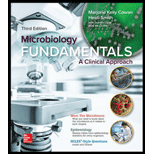
Microbiology Fundamentals: A Clinical Approach
3rd Edition
ISBN: 9781259709227
Author: Marjorie Kelly Cowan Professor, Heidi Smith
Publisher: McGraw-Hill Education
expand_more
expand_more
format_list_bulleted
Concept explainers
Question
Chapter 20.3, Problem 7AYP
Summary Introduction
To discuss: The important features of two categories of oral conditions: dental caries and periodontal diseases.
Introduction:
Infections or diseases refer to an abnormal condition of body that disrupts important physical and physiological function of body. Disease is caused by improper diet, lack of exercise, various infectious agents that are present in nature, toxic substances, genetic disorders, and depression, stress that play role in illness and disturbs normal functioning of body.
Expert Solution & Answer
Want to see the full answer?
Check out a sample textbook solution
Students have asked these similar questions
Define the meaning of the term "peptic ulcer disease". Discuss some of the risk factors that make people susceptible (including factors that protect the mucosa of the stomach/duodenum and those that cause damage to it.
ANSWER SHOULD INCLUDE:
Accurate definition, e.g. mucosa break greater than 3-5mm in the stomach or duodenum with a visible depth.
Discussion of factors e.g. infections (H. Pylori; others mainly in immunocompromised patients, e.g. cytomegalovirus ,tuberculosis, and syphilis), gastric bypass surgery, cigarette smoking, medication/drugs, physiological stress associated with critical illness (e.g. septicaemia), autoimmune diseases, eg, vasculitis, sarcoidosis, Crohn's disease.
Discussion of factors e.g. protection: bucarb, blood flow, prostaglandin, mucus. Damage: H. Pylori, gastric acid, pepsin, drugs e.g. NSAID
Differentiate between bacterial infectionand bacterial intoxication.
Discuss the importance of E. colias part of our intestinal flora.
Describe three (3) different types of gastrointestinal diseases caused by bacteria. Be sure to give the name of the specific organism that causes each, describe some common signs and symptoms and discuss treatment for each disease:
Define meningitis.Compare and contrast between bacterial and viral meningitis including treatment for each.
What is a prion? Describe the impact prionshave on the human brain and discuss two prion-associated diseases in humans:
What is a vector-borne (vector transmitted) disease? Give an example of a vector borne disease and the vector responsible for causing it:
Discuss the physiologic influence of various pathologies, such as peptic ulcer disease, gastritis, spastic colon, gastroesophageal reflux disease, and hyperacidic states, on the health of patients and their gastrointestinal tracts
Chapter 20 Solutions
Microbiology Fundamentals: A Clinical Approach
Ch. 20.1 - Prob. 1AYPCh. 20.1 - List the natural defenses present in the...Ch. 20.1 - Prob. 1NPCh. 20.2 - List the types of normal biota presently known to...Ch. 20.2 - Describe how our view has changed of normal biota...Ch. 20.3 - List the possible causative agents, modes of...Ch. 20.3 - Prob. 6AYPCh. 20.3 - Prob. 7AYPCh. 20.3 - Identify the most important features of mumps,...Ch. 20.3 - Differentiate among the main types of hepatitis,...
Ch. 20.3 - Prob. 1MMCh. 20.3 - Prob. 2NPCh. 20.3 - Prob. 3NPCh. 20.3 - Q. Why are the effects of jaundice so widespread...Ch. 20.3 - Prob. 4NPCh. 20.4 - Prob. 10AYPCh. 20.4 - Prob. 11AYPCh. 20.4 - Prob. 12AYPCh. 20.4 - Prob. 5NPCh. 20 - Prob. 1QCh. 20 - Healthy teeth are important for good nutrition and...Ch. 20 - Prob. 3QCh. 20 - Prob. 4QCh. 20 - Why is heating food contaminated with...Ch. 20 - Prob. 6QCh. 20 - Prob. 7QCh. 20 - Prob. 8QCh. 20 - Prob. 9QCh. 20 - Prob. 10QCh. 20 - Why is it thought that the Shiga toxin in...Ch. 20 - Prob. 12QCh. 20 - Prob. 13QCh. 20 - Prob. 14QCh. 20 - Prob. 15QCh. 20 - Prob. 16QCh. 20 - Describe the populations that are most at risk for...Ch. 20 - Prob. 18QCh. 20 - Prob. 19QCh. 20 - Prob. 20QCh. 20 - Prob. 21QCh. 20 - From chapter 11, figure 11.2a. Imagine for a...
Knowledge Booster
Learn more about
Need a deep-dive on the concept behind this application? Look no further. Learn more about this topic, biology and related others by exploring similar questions and additional content below.Similar questions
- Identify the side effects and special considerations associated with gastrointestinal system drug therapyarrow_forwardDescribe the steps that should be taken to reduce the chance of future outbreaks of gastroenteritis.arrow_forwardCan normal occlusion and ideal occlusion be both considered treatment goals in the clinical dental setting?arrow_forward
- Discuss the term chronic ulcerarrow_forwardEnumerate the major malabsorption syndromes. Write about the role of intestinal biopsyin the diagnosis of malabsorption syndromes. Discuss in detail the aetiopathogenesis ofcoeliac disease.arrow_forwardCompare the three diseases Celiac Disease, Crohn’s Disease, and Ulcerative Colitis with respect to: Symptoms Pathology and Diagnosis Treatmentarrow_forward
arrow_back_ios
SEE MORE QUESTIONS
arrow_forward_ios
Recommended textbooks for you

How stress affects your body - Sharon Horesh Bergquist; Author: TED-Ed;https://www.youtube.com/watch?v=v-t1Z5-oPtU;License: Standard Youtube License